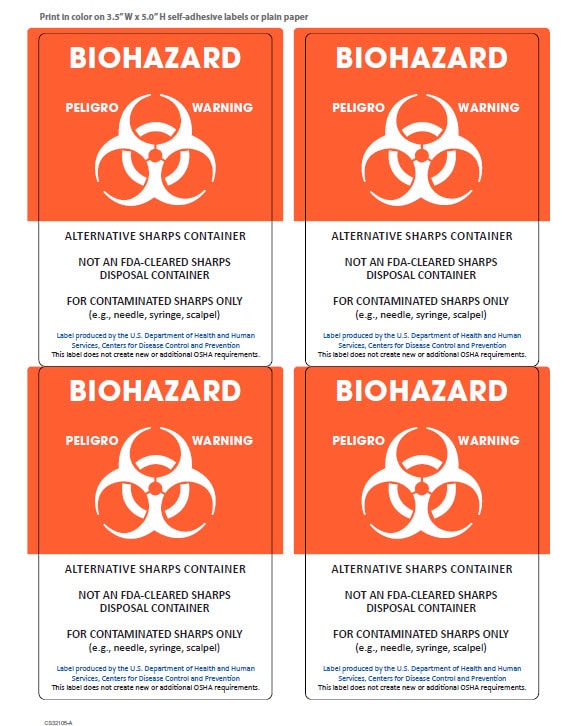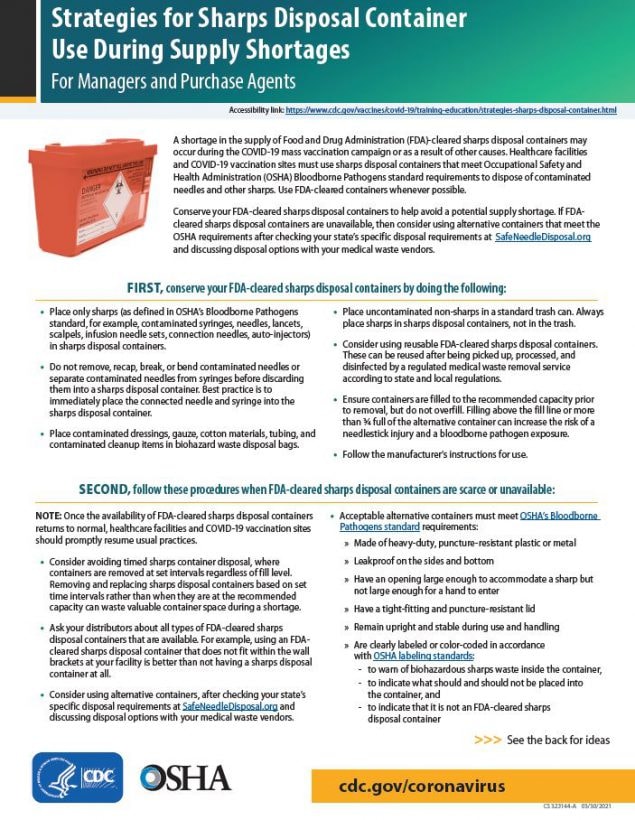Strategies for Sharps Disposal Container Use During Supply Shortages
For Managers and Purchase Agents
A shortage in the supply of Food and Drug Administration (FDA)-cleared sharps disposal containers may occur during the COVID-19 mass vaccination campaign or as a result of other causes. Healthcare facilities and COVID-19 vaccination sites must use sharps disposal containers that meet Occupational Safety and Health Administration (OSHA) Bloodborne Pathogens standard requirements to dispose of contaminated needles and other sharps. Use FDA-cleared containers whenever possible.
Conserve your FDA-cleared sharps disposal containers to help avoid a potential supply shortage. If FDA-cleared sharps disposal containers are unavailable, then consider using alternative containers that meet the OSHA requirements after checking your state’s specific disposal requirements at SafeNeedleDisposal.org and discussing disposal options with your medical waste vendors.
FIRST: Conserve your FDA-cleared sharps disposal containers
Place only sharps (as defined in OSHA’s Bloodborne Pathogens standard, for example, contaminated syringes, needles, lancets, scalpels, infusion needle sets, connection needles, auto-injectors) in sharps disposal containers.
- Do not remove, recap, break, or bend contaminated needles or separate contaminated needles from syringes before discarding them into a sharps disposal container. Best practice is to immediately place the connected needle and syringe into the sharps disposal container.
- Place contaminated dressings, gauze, cotton materials, tubing, and contaminated cleanup items in biohazard waste disposal bags.
- Place uncontaminated non-sharps in a standard trash can. Always place sharps in sharps disposal containers, not in the trash.
- Consider using reusable FDA-cleared sharps disposal containers. These can be reused after being picked up, processed, and disinfected by a regulated medical waste removal service according to state and local regulations.
- Ensure containers are filled to the recommended capacity prior to removal, but do not overfill. Filling above the fill line or more than ¾ full of the alternative container can increase the risk of a needlestick injury and a bloodborne pathogen exposure.
- Follow the manufacturer’s instructions for use.
SECOND: Follow these procedures when FDA-cleared sharps disposal containers are scarce
NOTE: Once the availability of FDA-cleared sharps disposal containers returns to normal, healthcare facilities and COVID-19 vaccination sites should promptly resume usual practices.
- Consider avoiding timed sharps container disposal, where containers are removed at set intervals regardless of fill level. Removing and replacing sharps disposal containers based on set time intervals rather than when they are at the recommended capacity can waste valuable container space during a shortage.
- Ask your distributors about all types of FDA-cleared sharps disposal containers that are available. For example, using an FDA-cleared sharps disposal container that does not fit within the wall brackets at your facility is better than not having a sharps disposal container at all.
- Consider using alternative containers, after checking your state’s specific disposal requirements at SafeNeedleDisposal.org and discussing disposal options with your medical waste vendors.
- Acceptable alternative containers must meet OSHA’s Bloodborne Pathogens standard requirements:
- Made of heavy-duty, puncture-resistant plastic or metal
- Leakproof on the sides and bottom
- Have an opening large enough to accommodate a sharp but not large enough for a hand to enter
- Have a tight-fitting and puncture-resistant lid
- Remain upright and stable during use and handling
 [PDF - 142 KB, 1 page]
[PDF - 142 KB, 1 page]Printable label for alternative sharps disposal containers
Alternative Languages: Spanish |Korean | Simplified Chinese | Vietnamese
Are clearly labeled or color-coded in accordance with OSHA labeling standards:
- to warn of biohazardous sharps waste inside the container,
- to indicate what should and should not be placed into the container, and
- to indicate that it is not an FDA-cleared sharps disposal container
Alternative sharps disposal containers must meet OSHA requirements and may include:
- Heavy-duty plastic household containers, such as empty plastic laundry detergent, windshield wiper fluid, cat litter, or bleach containers that have been emptied and thoroughly rinsed
- New, never used, heavy-duty paint or chemical buckets with a secure lid and a removeable spout large enough for sharps to be inserted but too small for a hand to enter
- New, never used, heavy-duty plastic or metal gas or diesel fuel containers with tight caps
- New, never used, heavy-duty plastic chemical-dispensing containers (2.5 or 5 gallon) with tight caps
Report supply shortages to the FDA
The FDA encourages health care facilities to report any supply disruptions of sharps disposal containers to the device shortages mailbox deviceshortages@fda.gov. This mailbox is monitored closely and is a valuable resource to augment FDA efforts to detect and mitigate potential supply chain disruptions.
- FDA: How to get rid of a sharps container
- FDA: Sharps disposal containers
- NIOSH (National Institute for Occupational Safety and Health): Preventing needlestick injuries at COVID–19 vaccination sites
- NIOSH: Selecting, evaluating, and using sharps disposal containers
- OSHA: Bloodborne Pathogens standard
- OSHA: Bloodborne pathogens and needlestick prevention
- OSHA: Poster for COVID-19 vaccination sites
